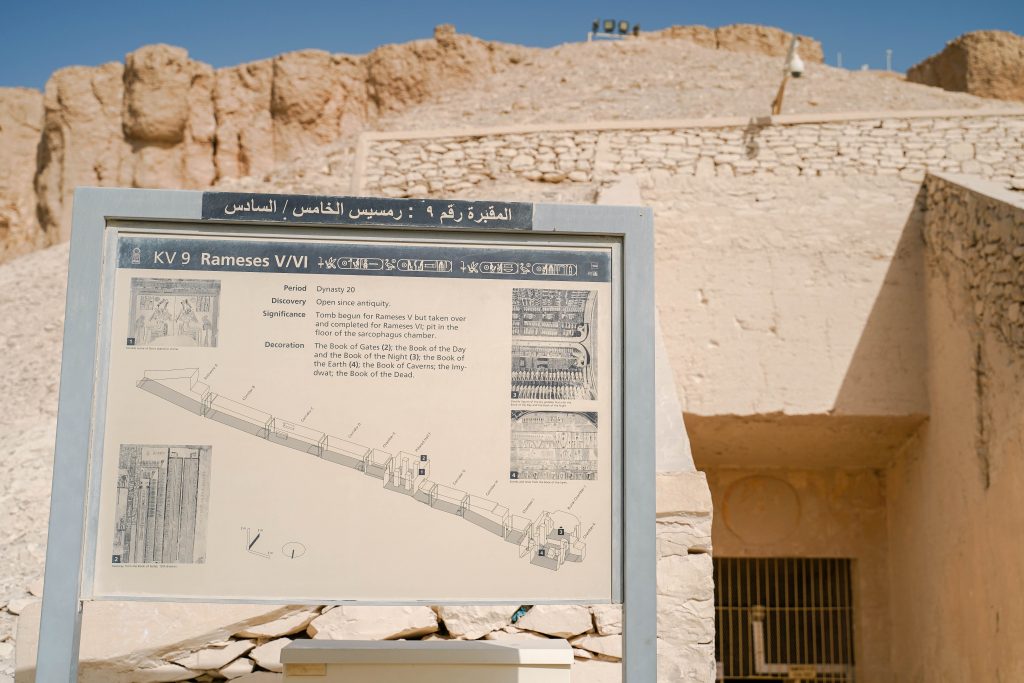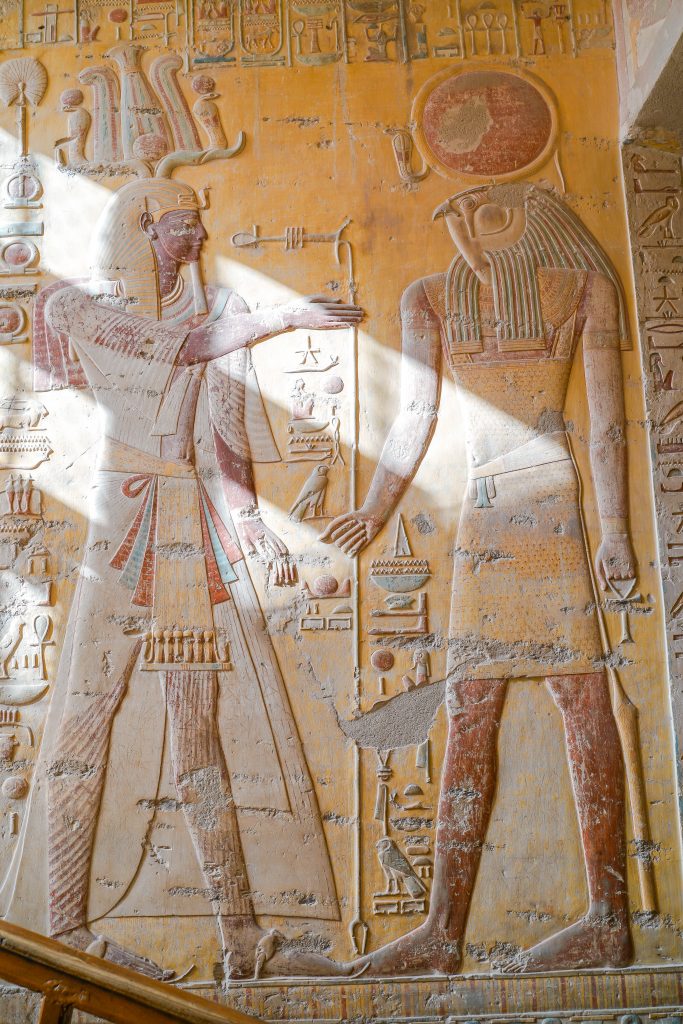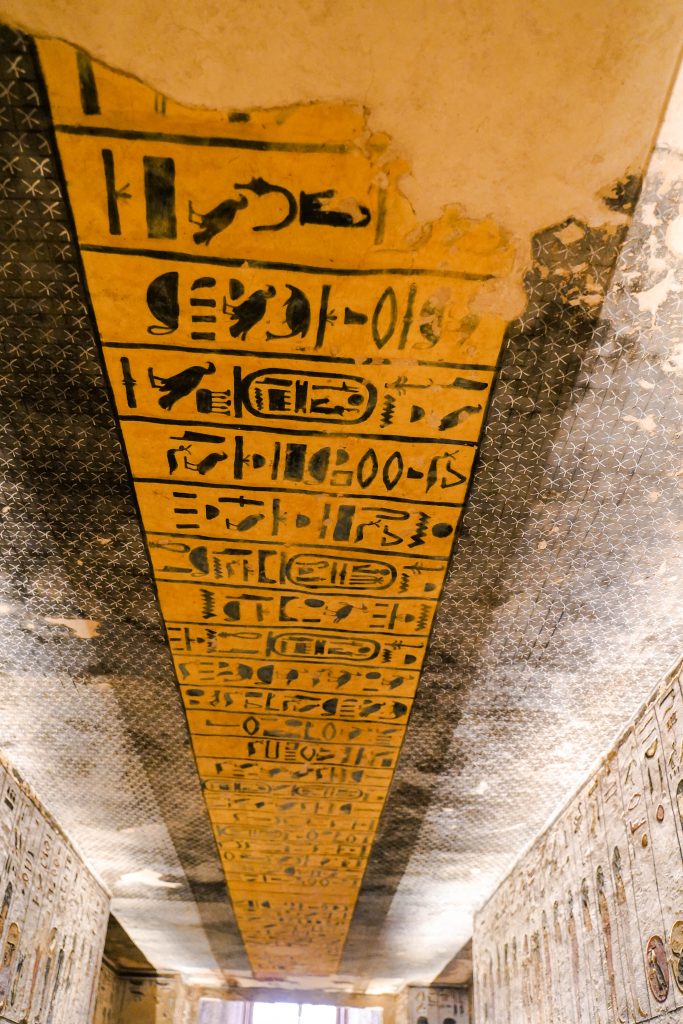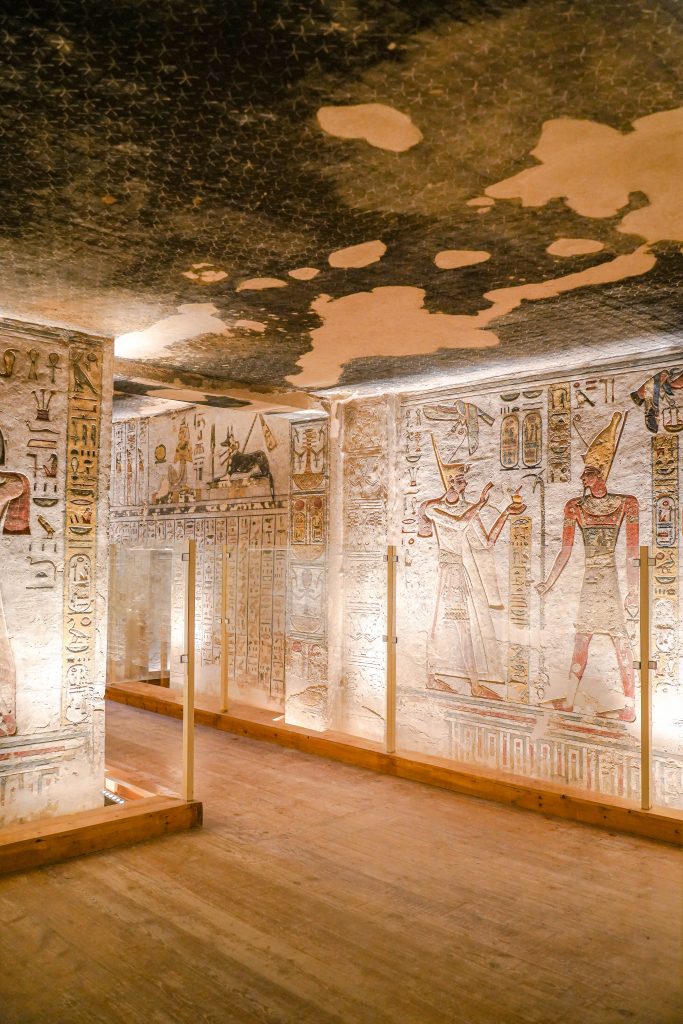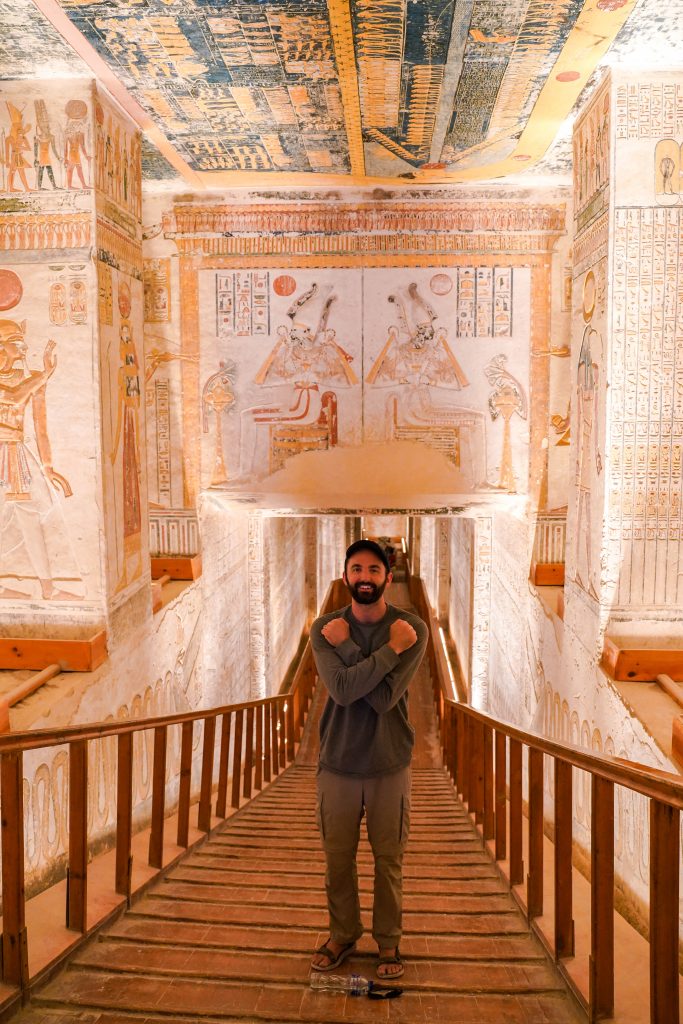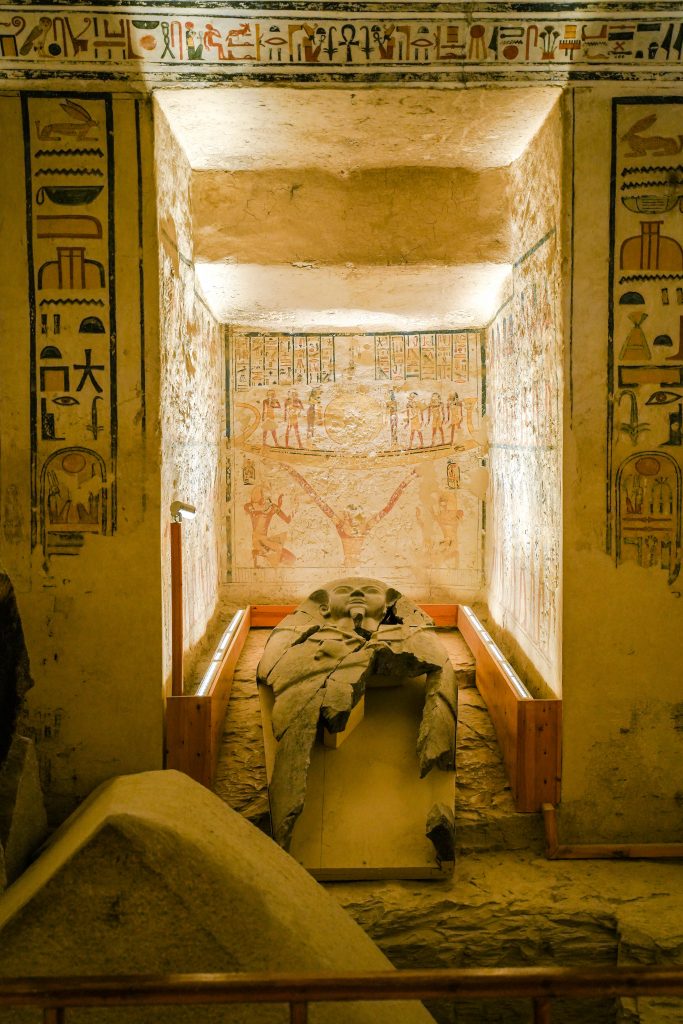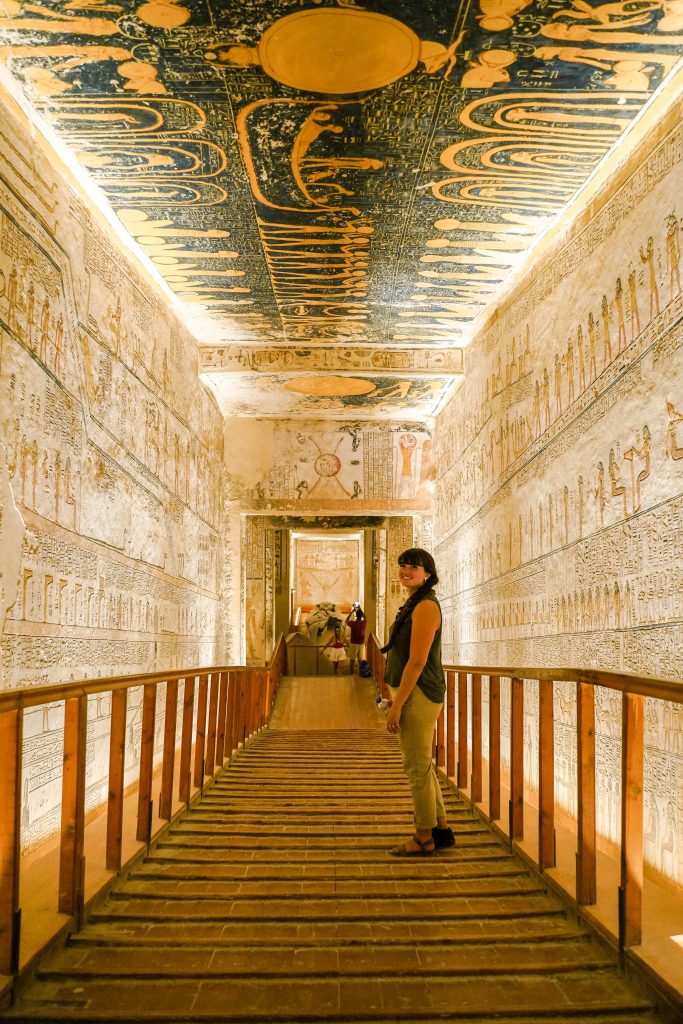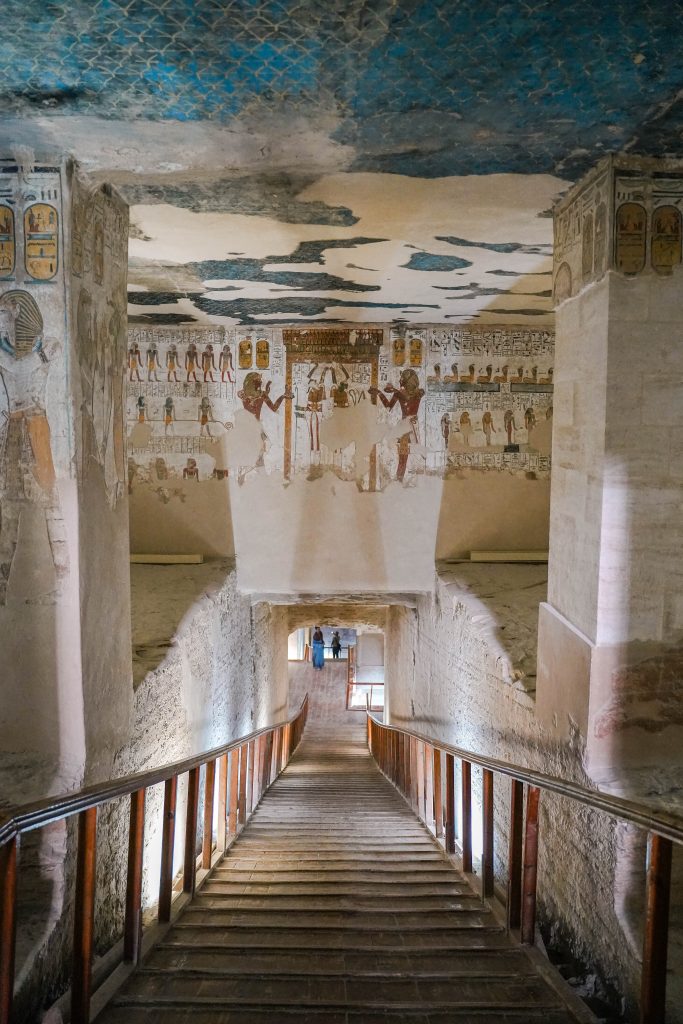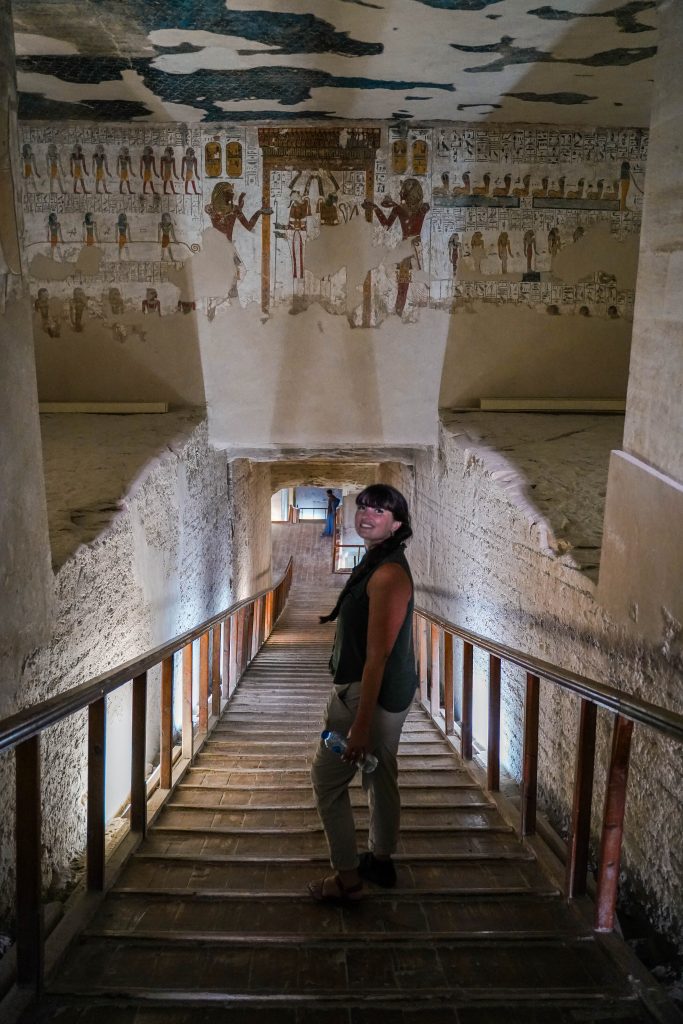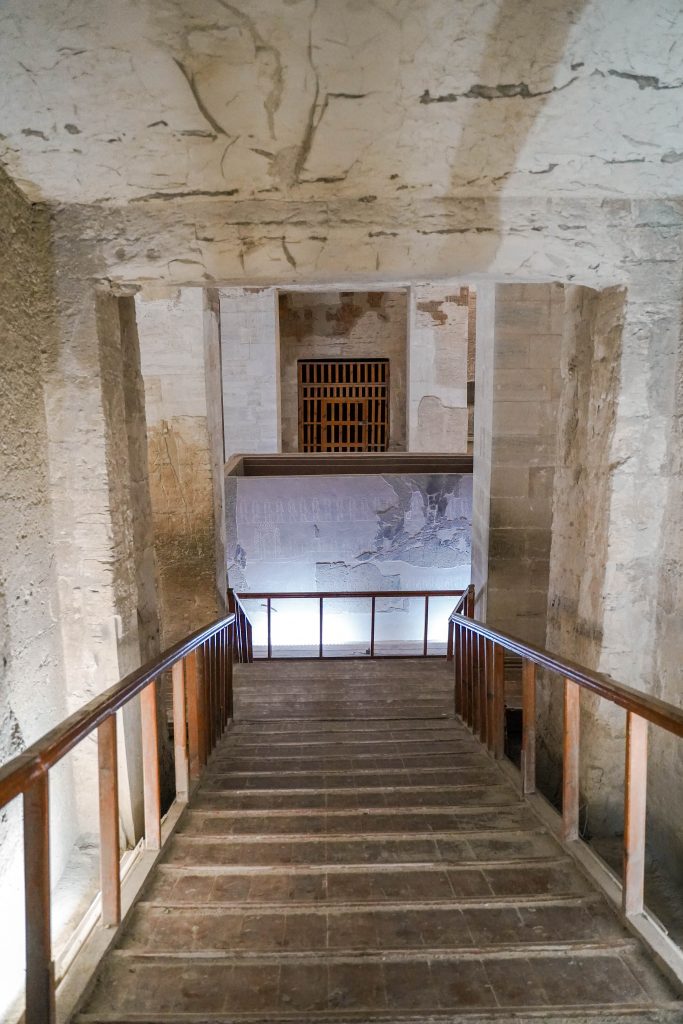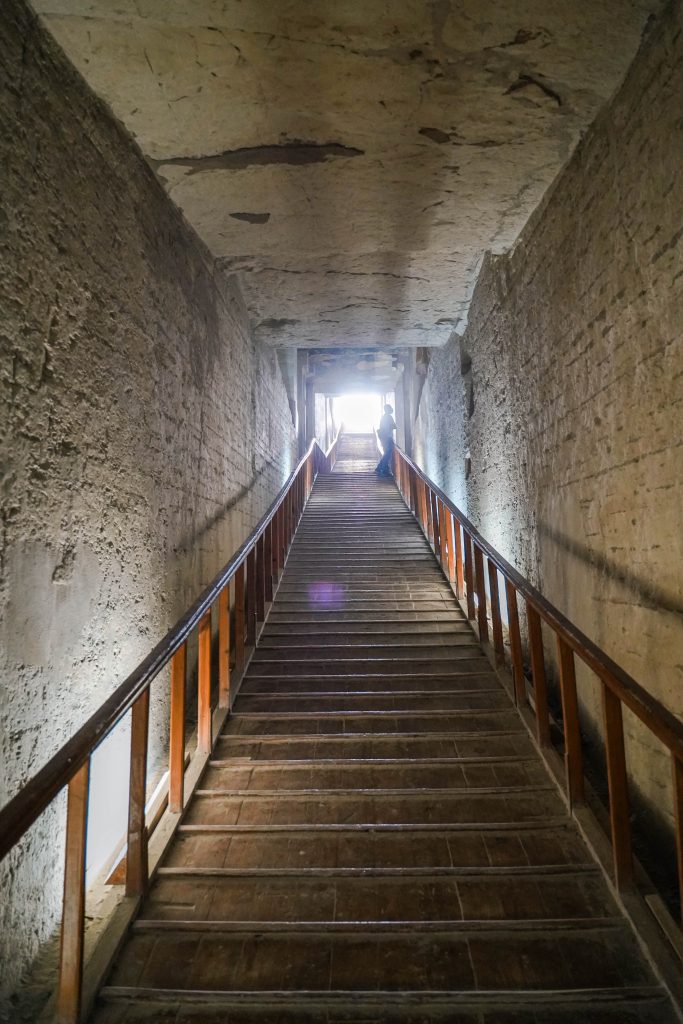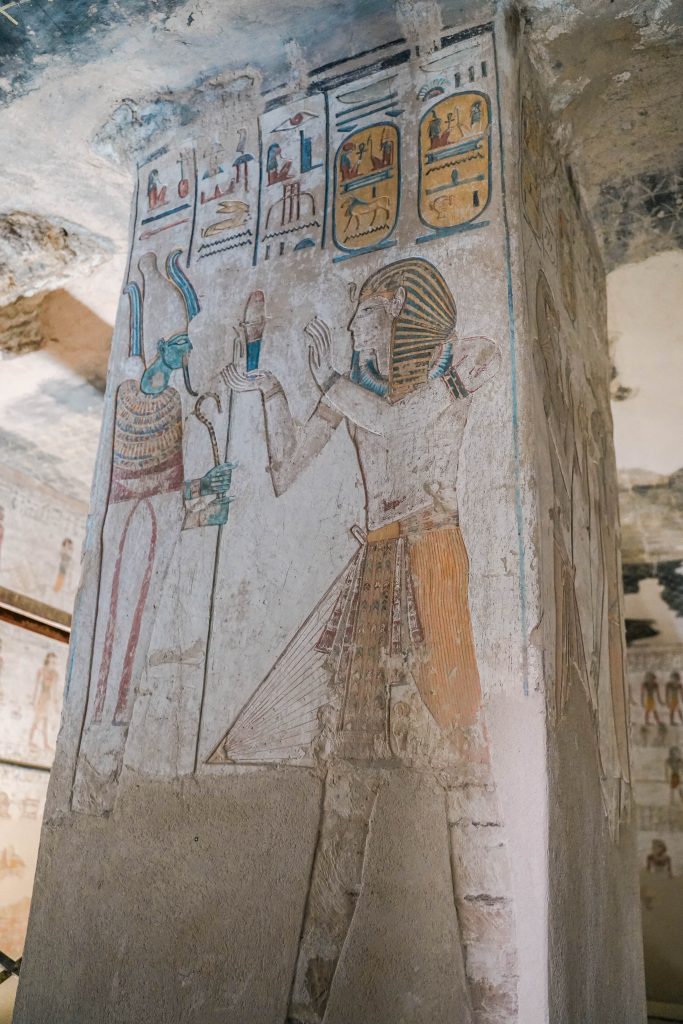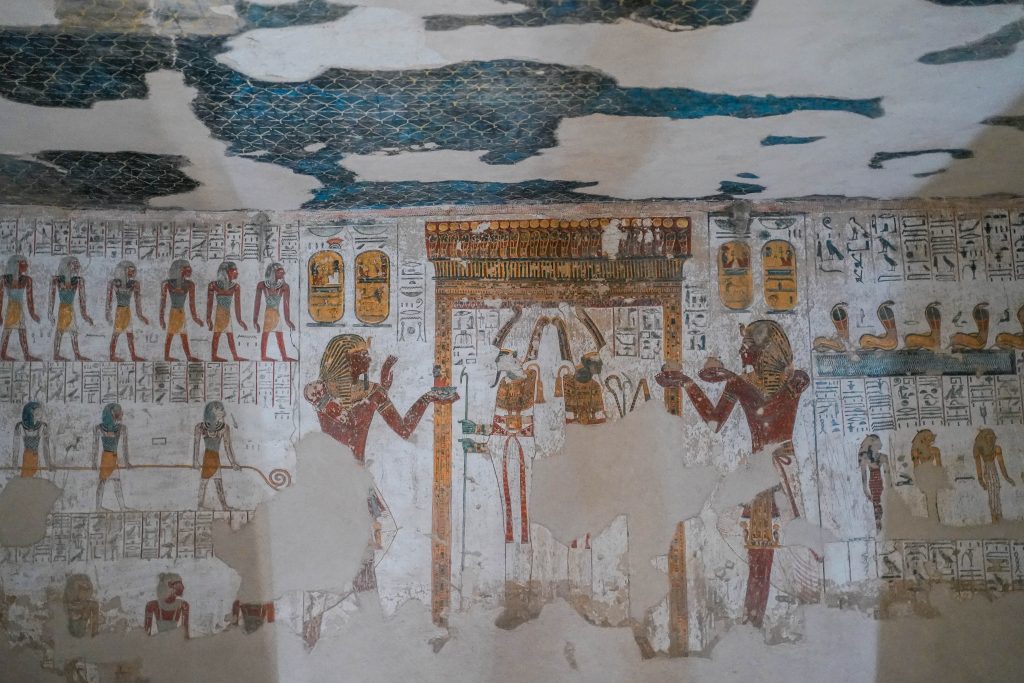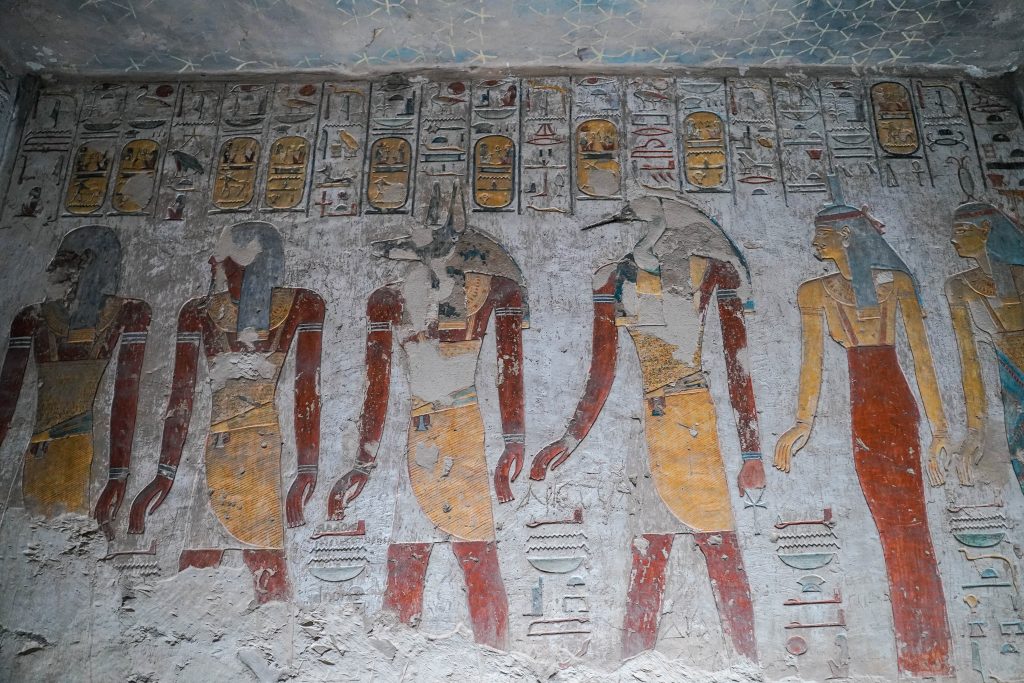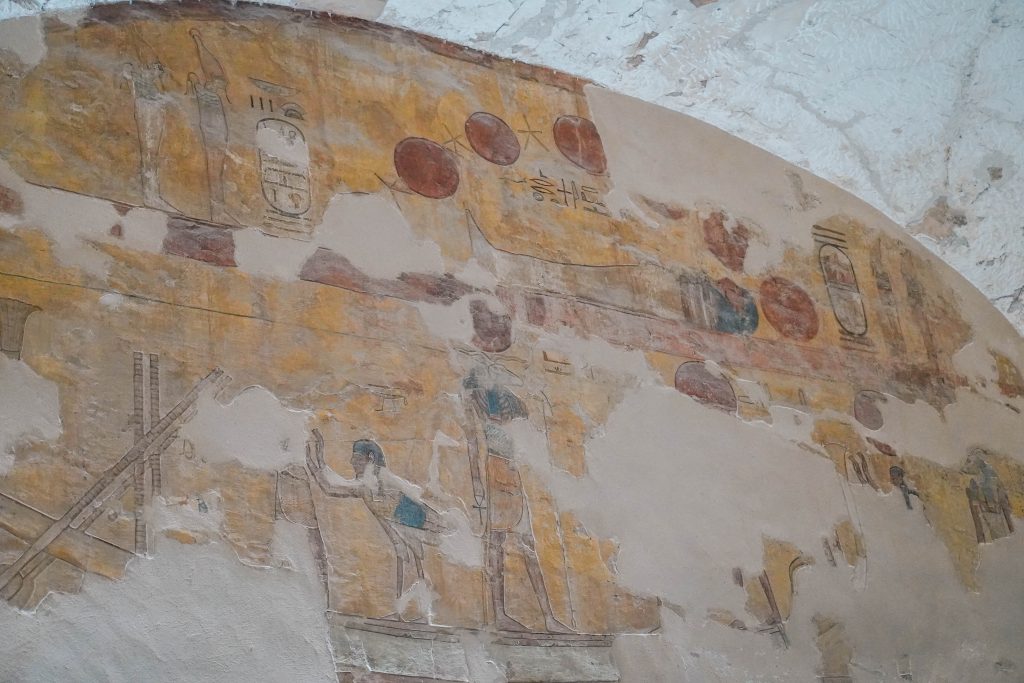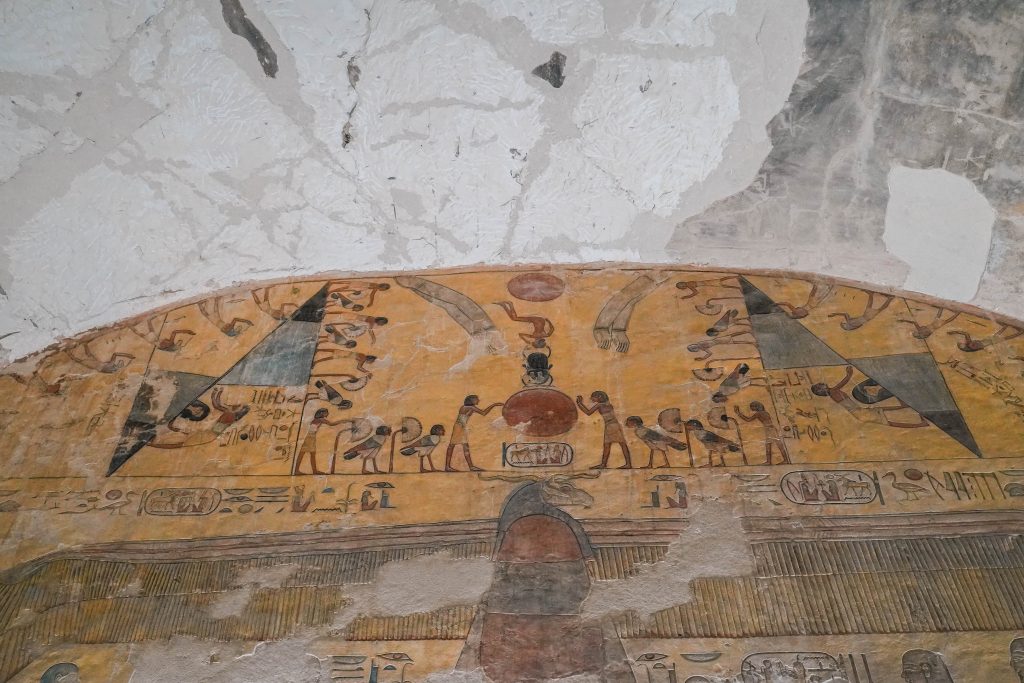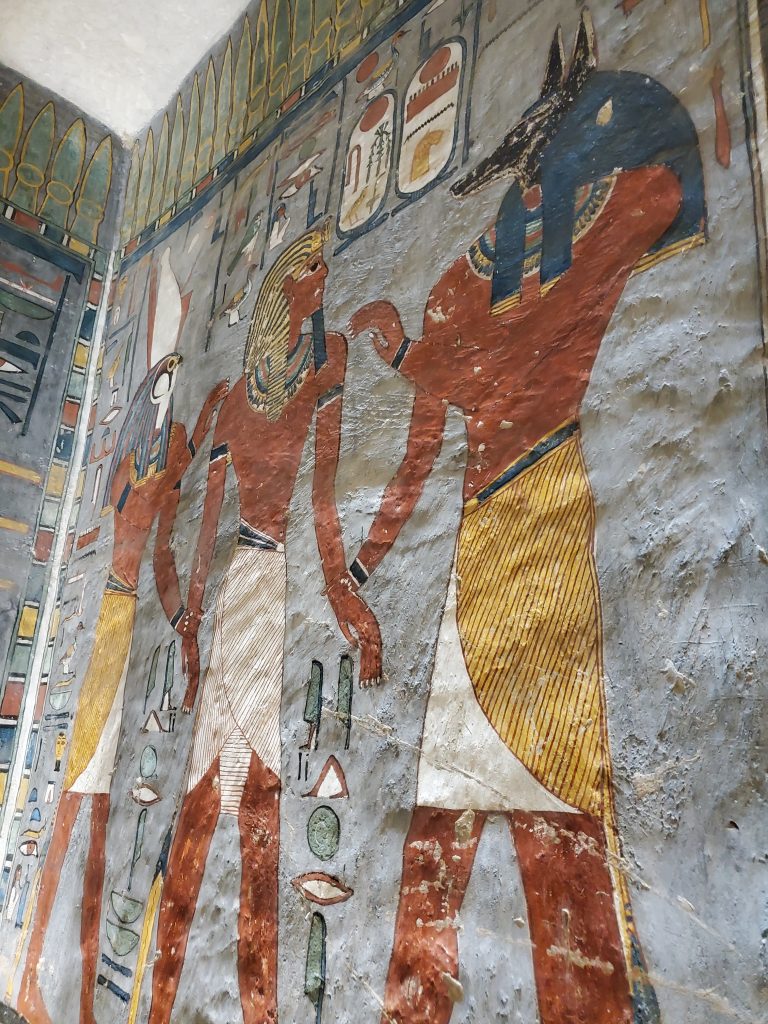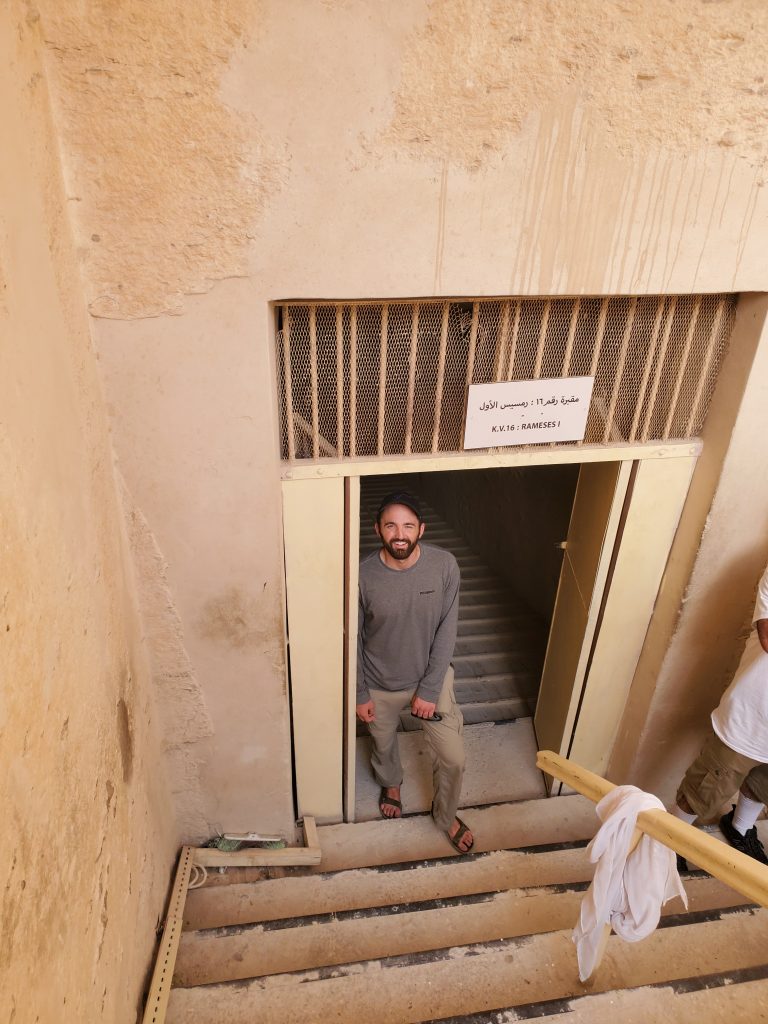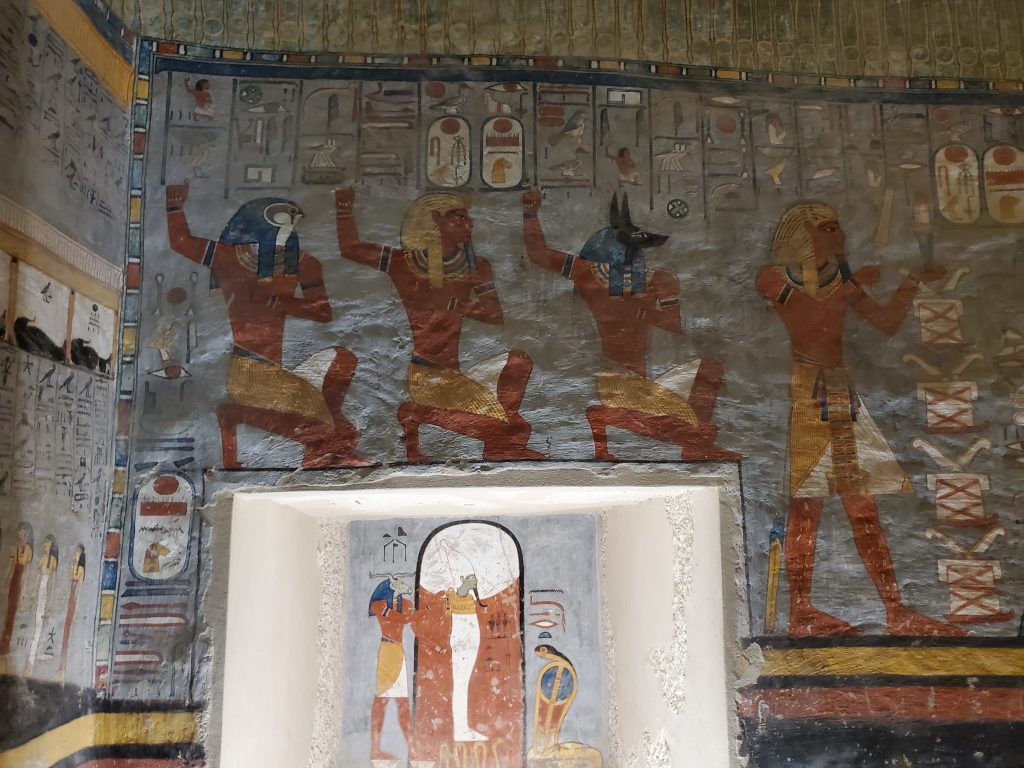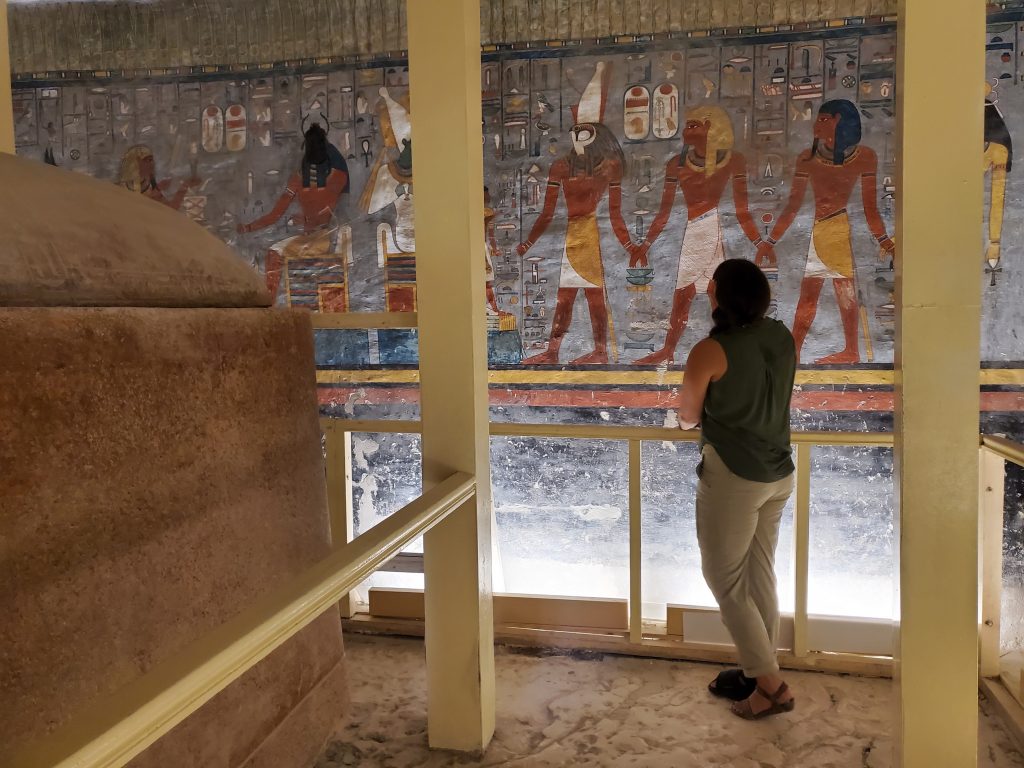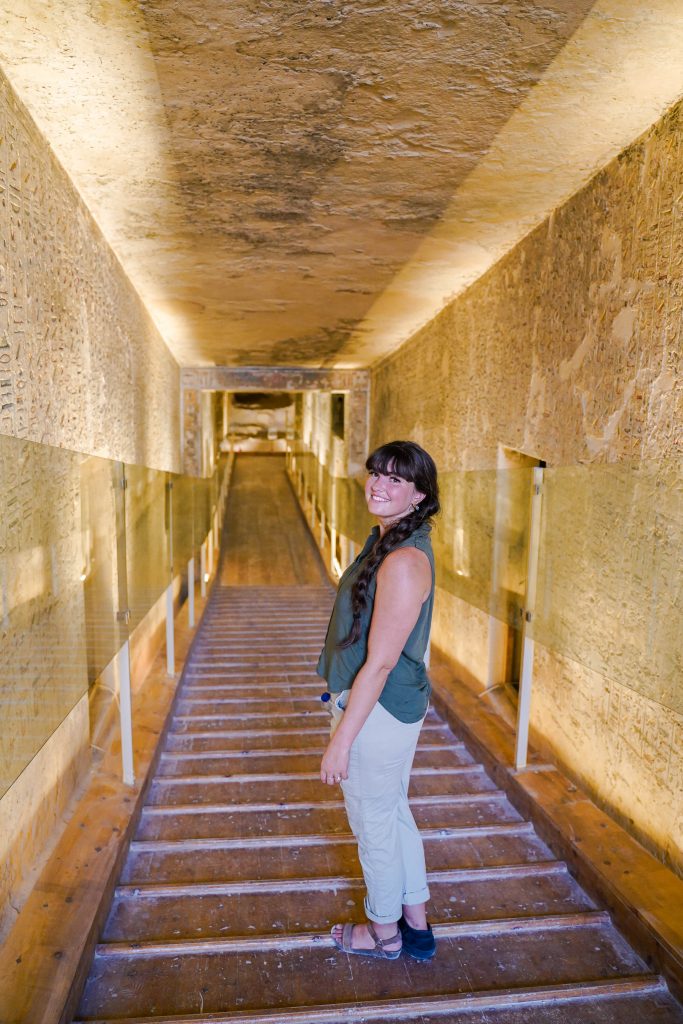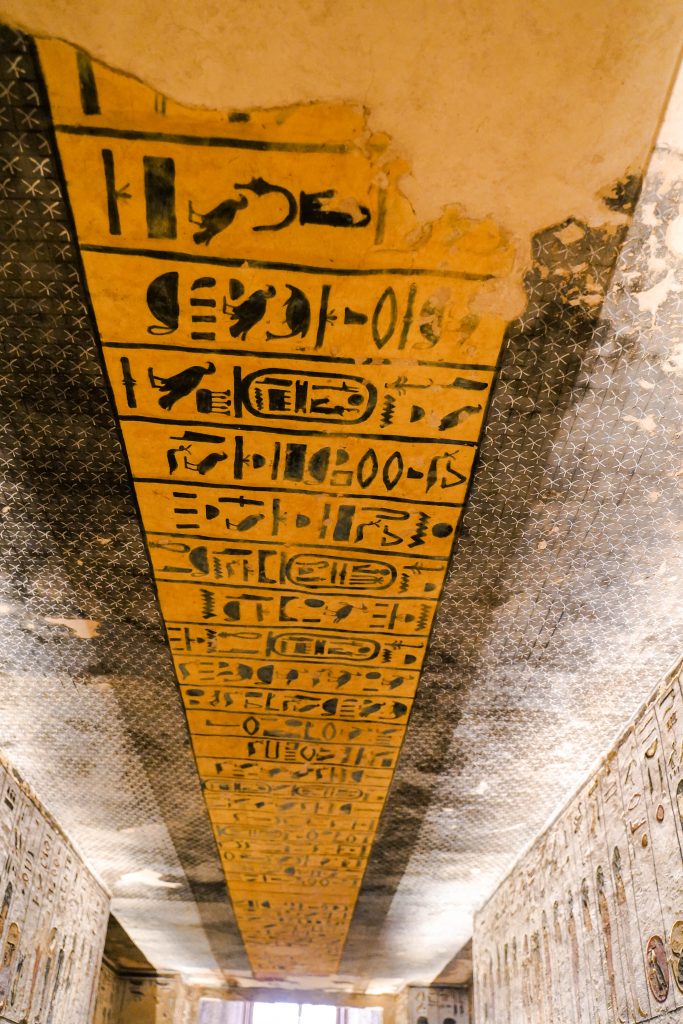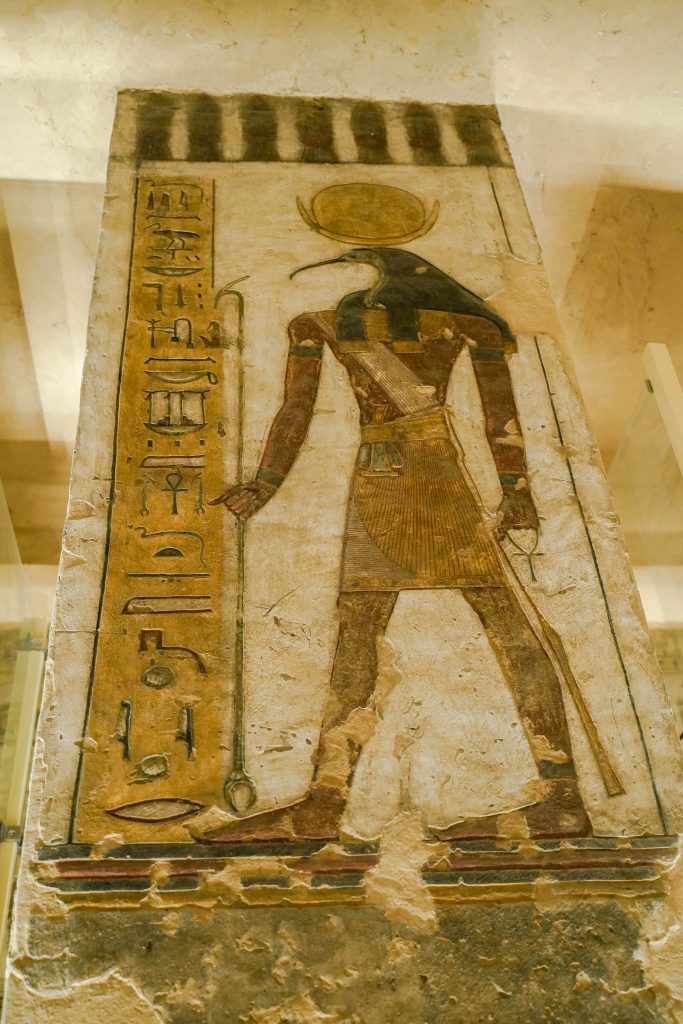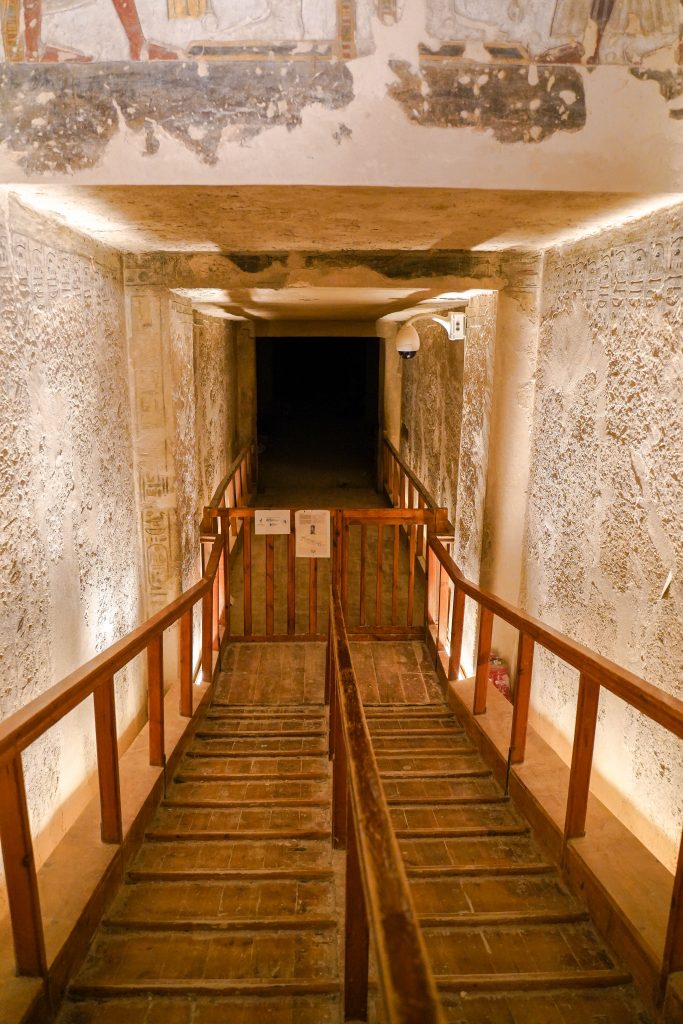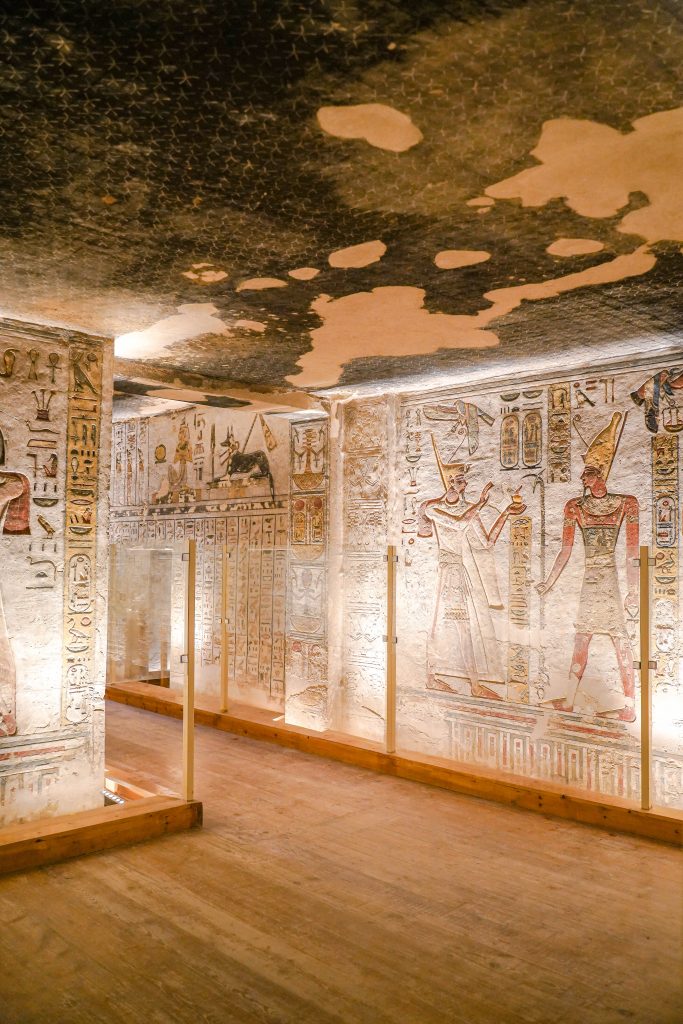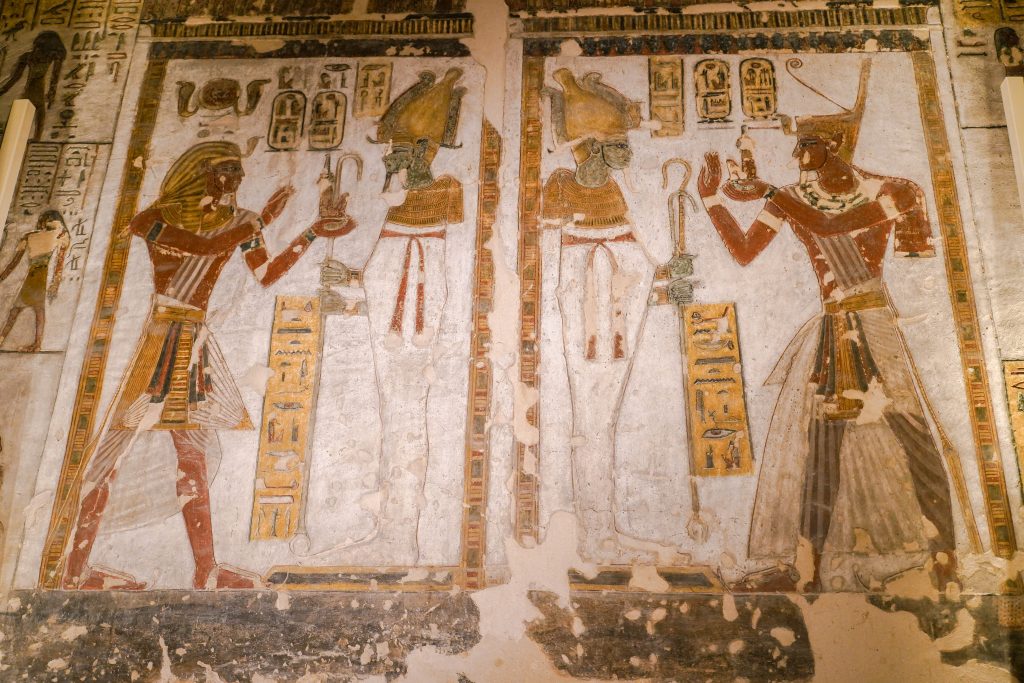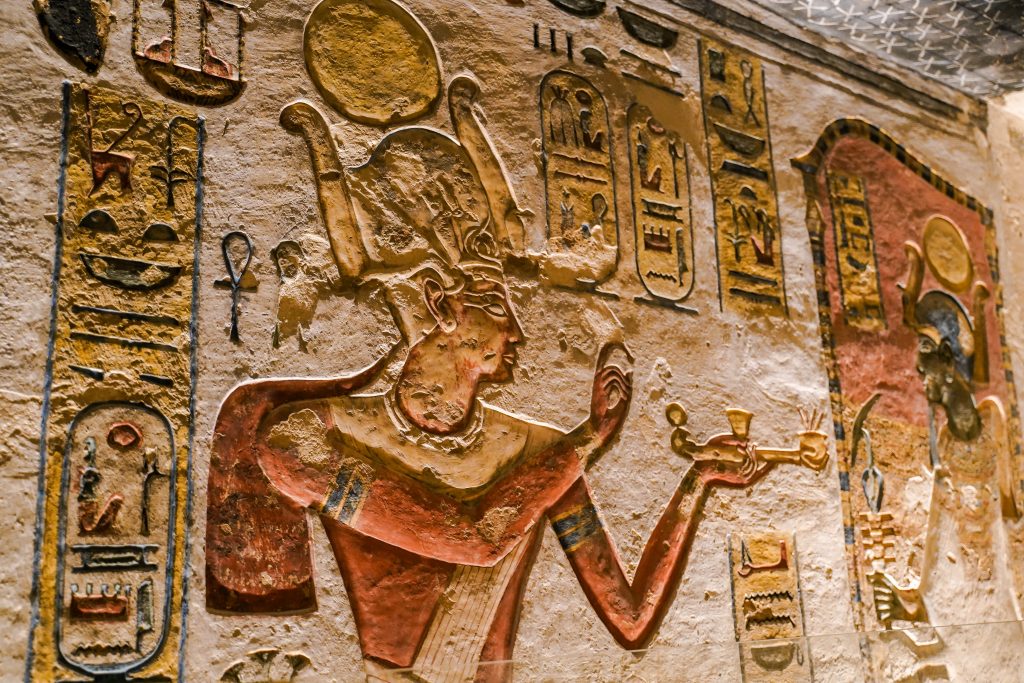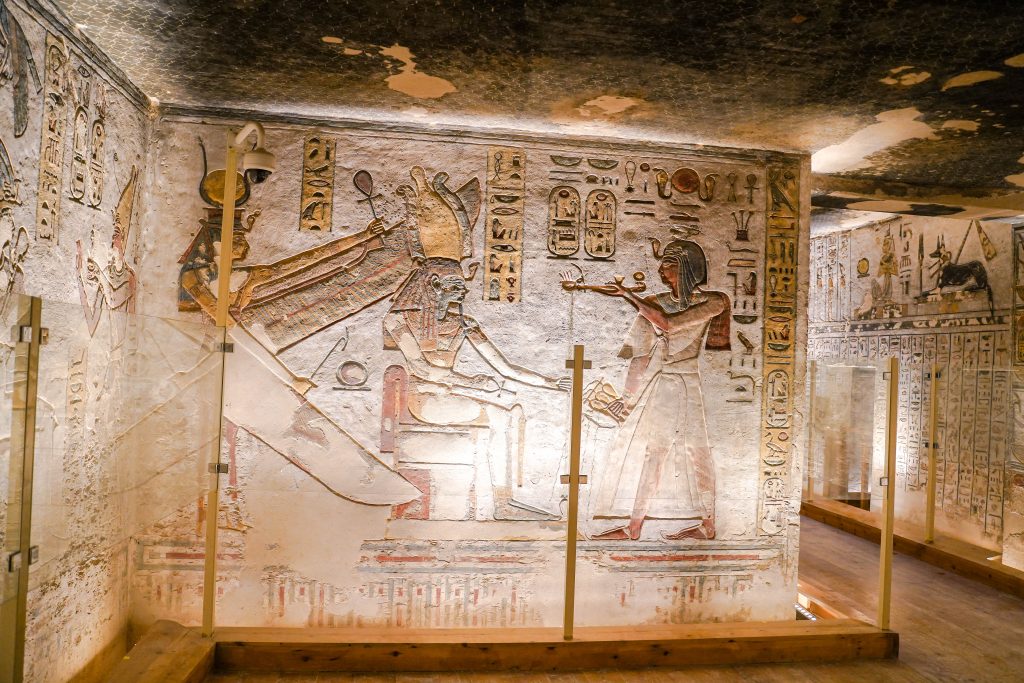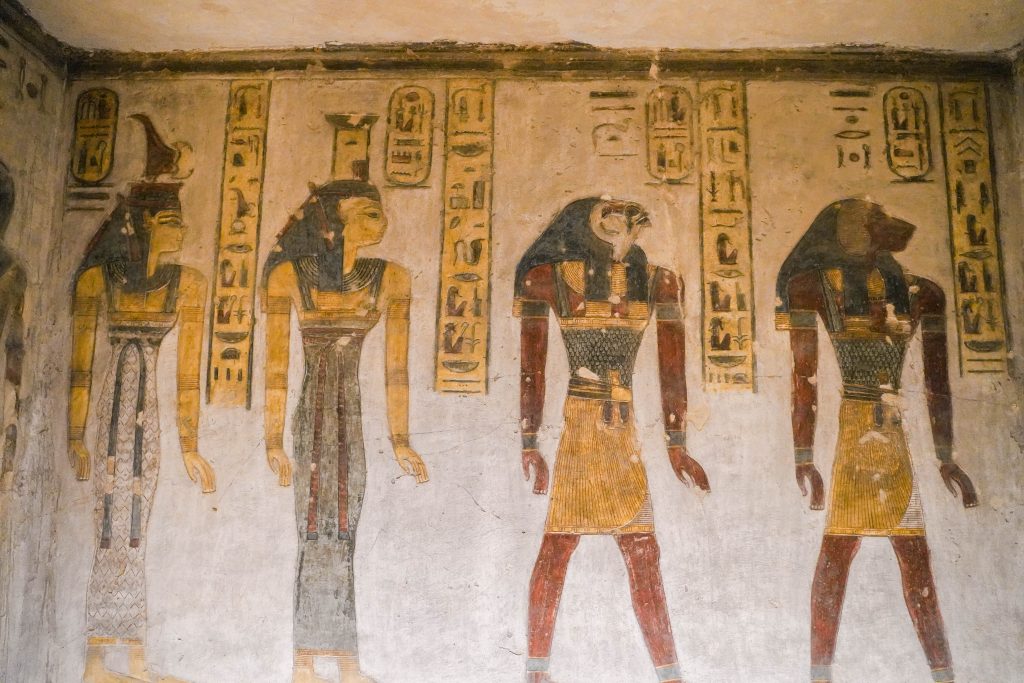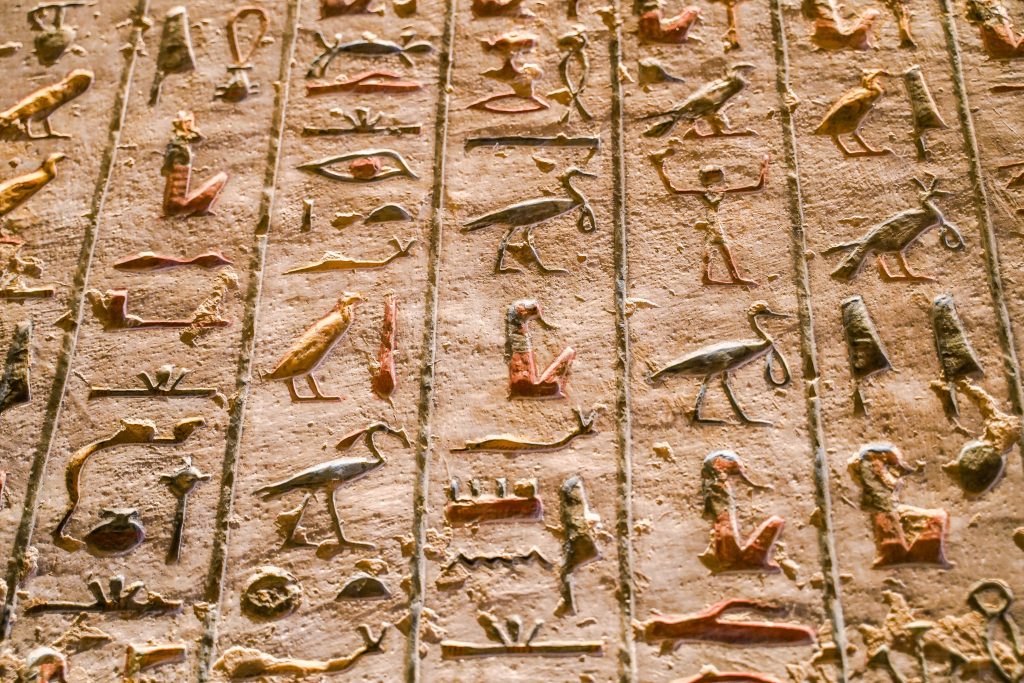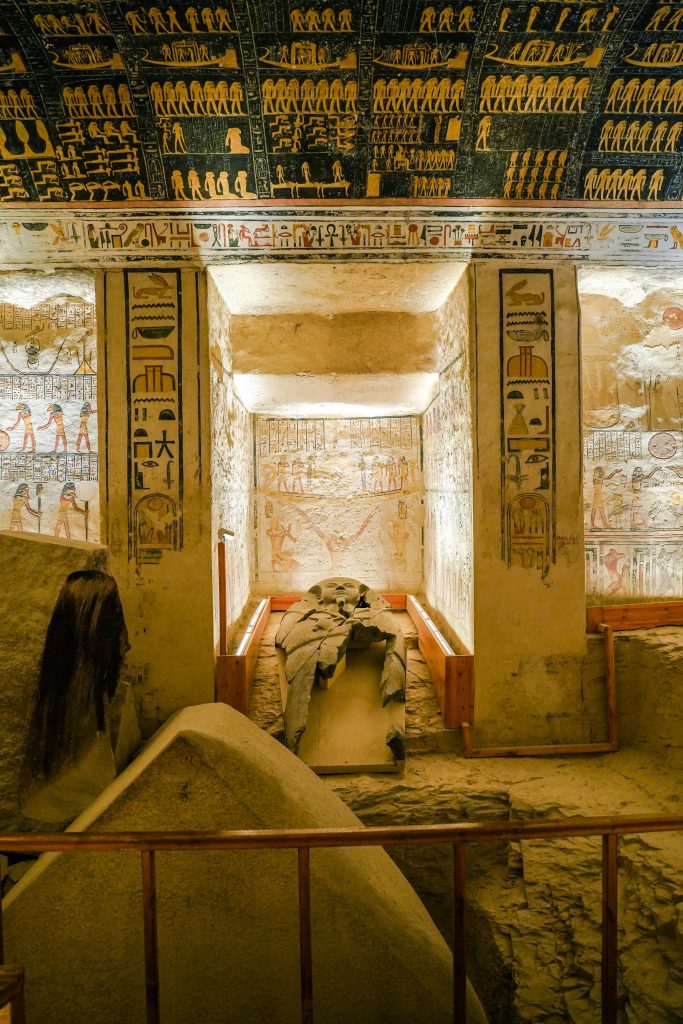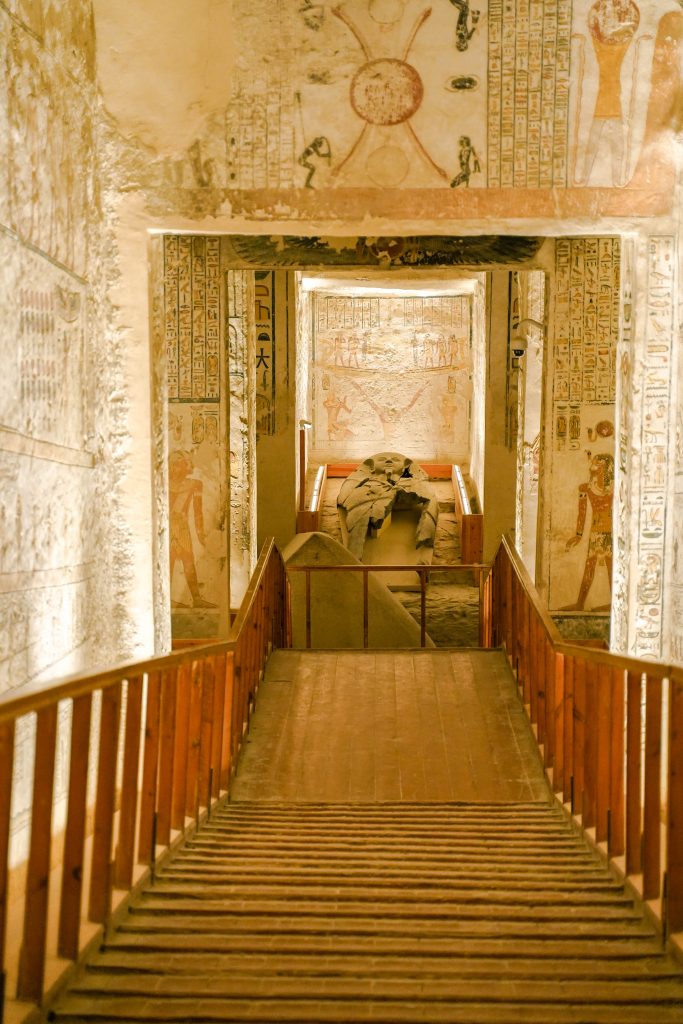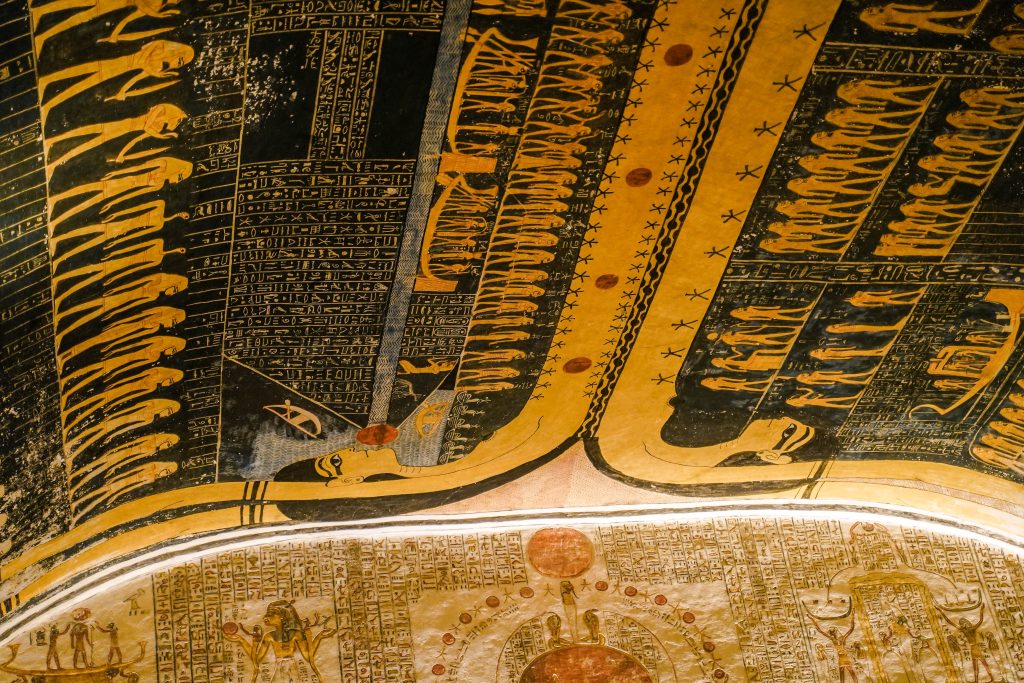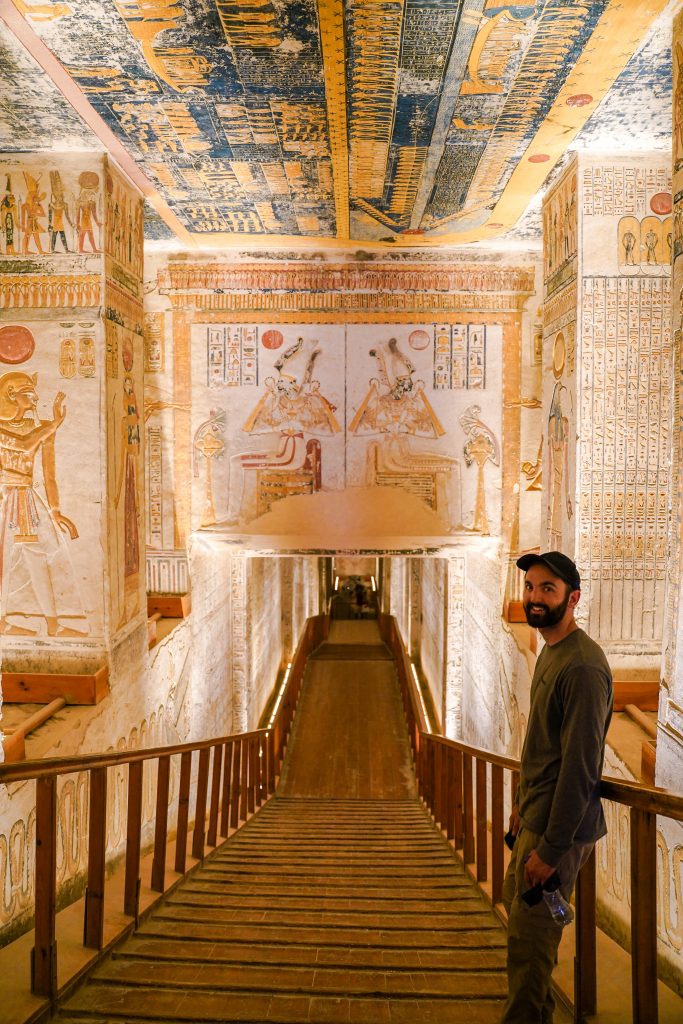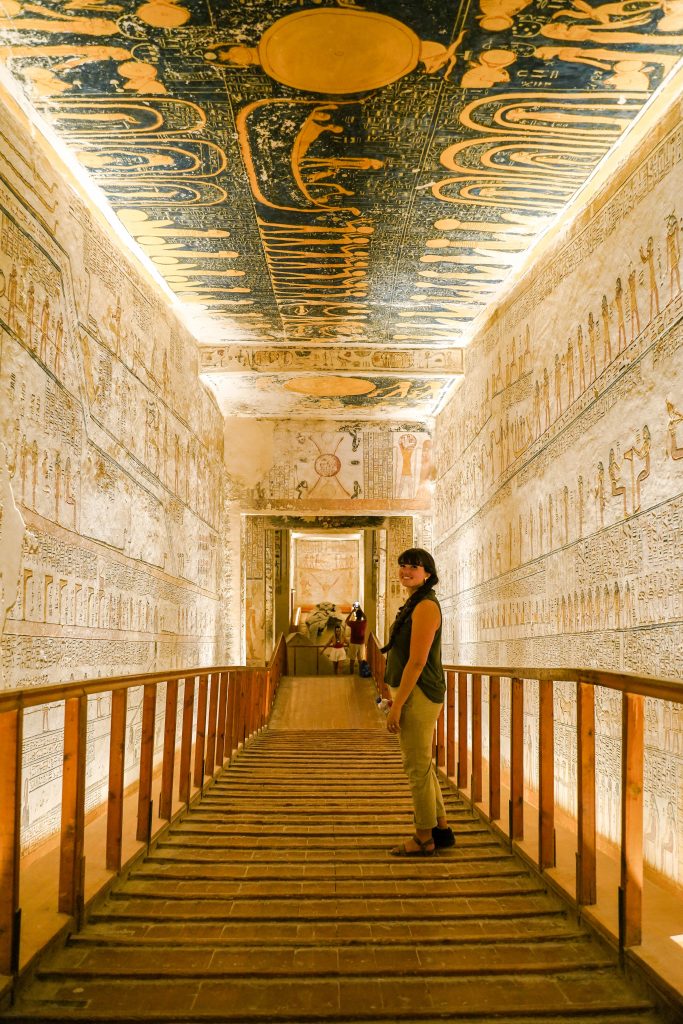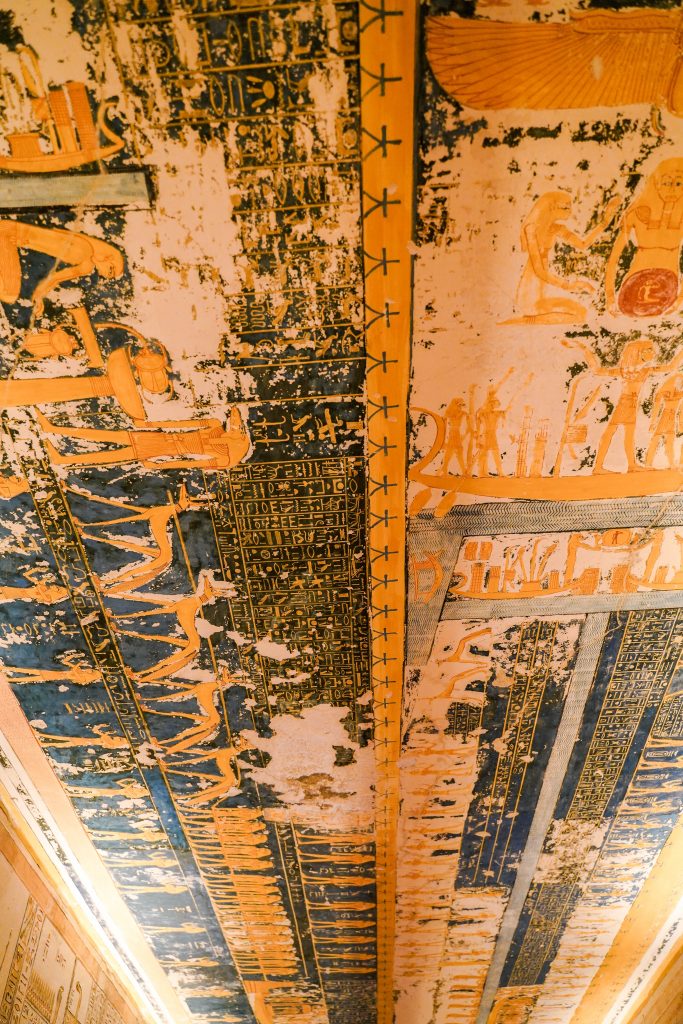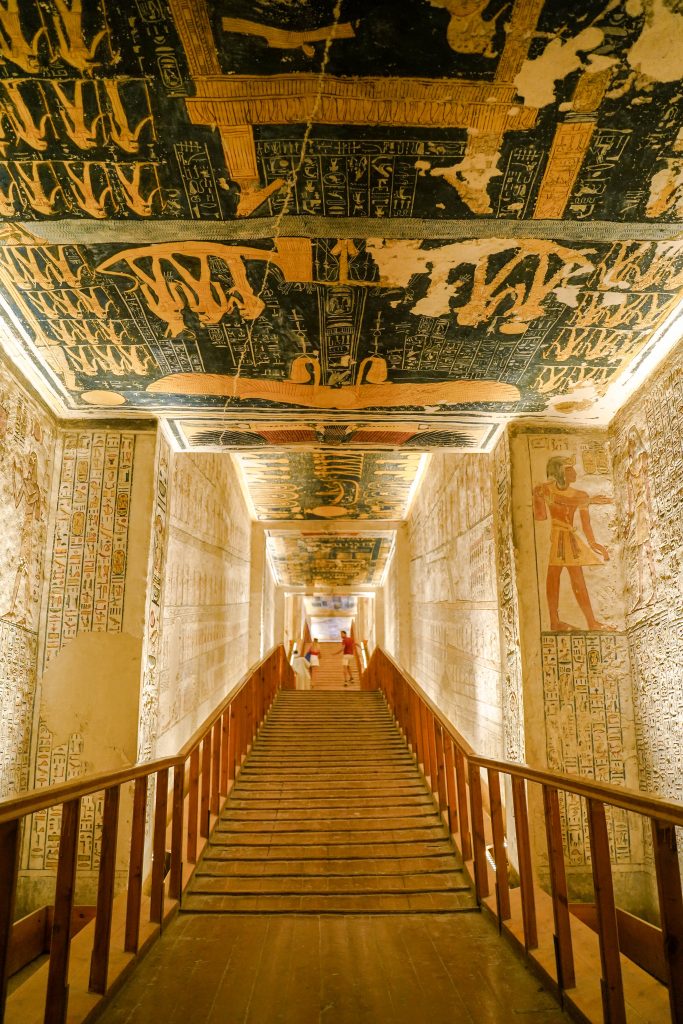Another must see on any trip to Egypt is the valley of the kings, making a journey to Luxor well worth it. The valley of the kings is made up of at least 63 known tombs with 20 or so belonging to known kings. The tombs are not as grand in scale as the temples and are mostly devoid of any antiquity now- however the art work on the walls is really impressive to see.
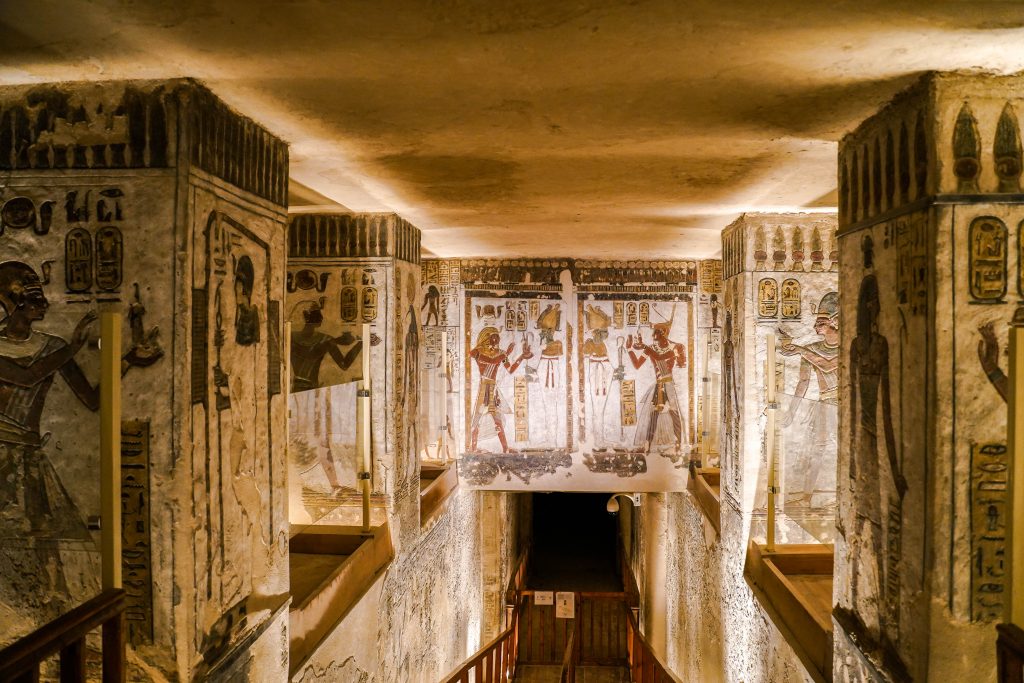
The colors are all original and almost all the wall space (including the ceilings) is covered. The way the tombs have been preserved against time is really incredible to witness in person, as is walking the steep narrow corridors down into the rock.
*Most of my photos are near the bottom in the section assigned to the tombs we saw. If you’re here for the pics, scroll on down.
Post Index:
- History of Valley of the Kings
- Location and design
- Information for visiting
- Tombs we visited:
- Tomb of Merenptah (KV8)
- Tomb of Ramesses I (KV16)
- Tomb of Ramesses III (KV11)
- Tomb of Ramesses V and VI (KV9)
About the Valley of the Kings
History
The tombs in the valley of the kings house kings, royals, and other important political figures that reigned during the new kingdom of Egypt. (1570 BC to about 1077 BC) Important key pharaohs you learn about through other sites like Abu Simbel and the Luxor temples were buried here with the most famous including King Ramesses II (most known for building a lot of the great monuments), King Ramesses III (largely known as the last great pharoah), and King Tut (the boy king whose tombs was just discovered in 1922 intact).
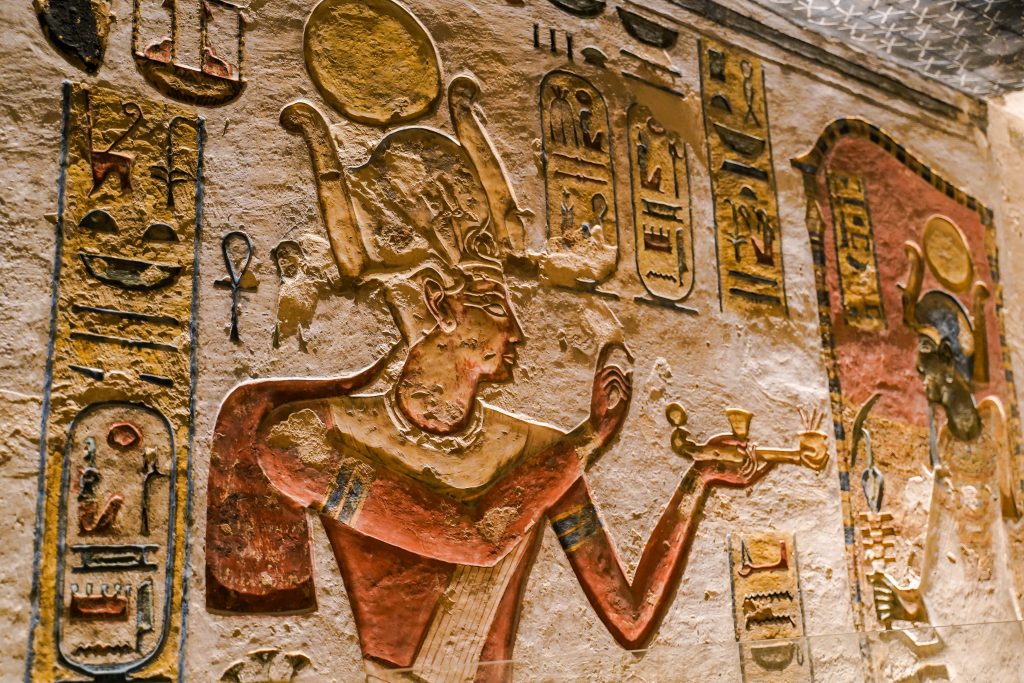
Location
Location of the valley of the kings comes down to 2 very important aspects. The first is that it is on the west bank of Luxor (ancient day Thebes- the capitol for many kings) The Egyptians built their temples and homes on the east bank in order to greet the rising sun as a sign of life. Mostly tombs and mortuary temples were built on the west bank to represent the fading of the sun and the afterlife.
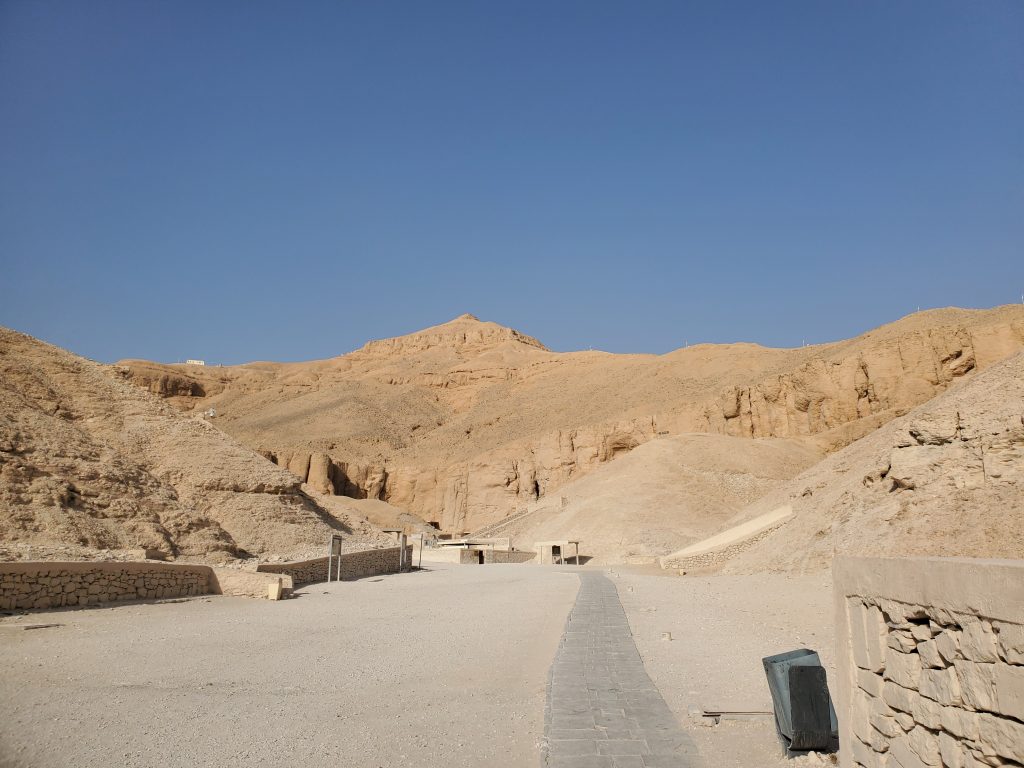
The second thing to note is the valley is located under the mountain peak Al-Qurn which has a pyramid-shaped appearance. This echoes the old kingdom (the actual pyramids) and symbolizes those who are buried there being closer to the gods through the peak of the mountain.
Design
The usual tomb architecture includes a long corridor usually depicting spiritual and religious texts. A lot of the tombs (the newer ones specifically) contain the book of the gates which shows the sun god passing through the 12 gates of night on his journey back to day. This was meant to help the owner of the tomb make their way through the 12 gates of night as well and rise again with the sun god. Some of the older tombs have a 90 degree bend that was on purpose in order to fill the upper corridrs with rubble and conceal the entrance to the tomb. Later tombs have bends in the corridor as well which is more due to unwittingly digging into someone else’s tomb and needing to divert in order to continue finishing the tomb. (King Ramesses III is a good example of this)
The ceilings of the burial chambers were usually decorated with the Book of the Heavens, which also describes the sun’s journey through the 12 hours of night. Major players who are represented in this artwork of the tombs are scarabs who were instrumental in protecting and helping the sun disk, Anubis, the god who presides over the embalming process and accompanies dead kings to the afterlife, and Nut the goddess of the sky and stars who frequents the ceilings in many tombs and temples.
Information for visiting the valley of the kings
Tickets:
With the standard entrance ticket, you are permitted to enter 3 tombs (out of many) however there are some tombs that cost more and require an extra ticket. If you go with a guide, they will likely tell you which tombs are the most impressive to see on your trip. I’ll review the 4 tombs we went visited in more detail below but here is an overview of the tombs worth visiting.
The standard entrance ticket cost is:
240 EGP ($15 USD) per person
Discounts are available for children or students for 120 EGP.
*It is important to note the tombs are on a rotation schedule and some of these may be closed to visitors during your visit. This is to protect the delicate reliefs and paintings from the carbon dioxide, friction, and humidity from hot sweaty tourists.
Best tombs to visit included on the standard ticket:
Tomb of Ramesses I (KV16)
Tomb of Ramesses III (KV11)
Tomb of Ramesses IV (KV2)
Tomb of Ramesses IX (KV6)
*Again it is likely these won’t all be open on your visit. Only the first 2 were open when we visited.
Tombs you can pay extra to visit:
Tomb of Ramesses V and VI (KV9) – Requires an extra 100 EGP ($6 USD) per person. Absolutely worth it. This was our favorite tomb
Tomb of Seti I – Extra ticket costs a whopping 1000 EGP ($64 USD) per person. Photos and everything I’ve seen of this tomb don’t really seem worth the high price to me but if you’re looking for a tomb with multiple rooms, this one has a more adventurous feeling to it.
Tomb of Tutankhamun (famous King Tut) (KV62) – Extra ticket costs 300 EGP ($18 USD) per person. Not the fanciest of tombs but you can see his mummy still in his tomb. If you visit the Egyptian museum, you’ll see better preserved mummies and most of King Tut’s tomb collection. So may or may not be worth it.
Photography:
When we went, taking pictures and videos with your phone is free. Taking pictures or videos with anything other than a phone requires a photography ticket. This includes DSLRs, small handheld point and shoot cameras, and even gopros. (we saw someone get caught with a gopro and seemed like they were in for it) It’s most important to note that the photography ticket ONLY COVERS 3 TOMBS. So if like us you bought a ticket for an extra tombs, bring a bag to put your camera in for one of them. They punch a hole in your ticket to keep track.
The photography ticket is pricey and cost 300 EGP (about $19 USD) per camera. Luckily Braden doesn’t really care so we just bought one ticket to cover my camera.
The facilities
There is an electric train that will take you from the visitor center to the beginning of the tombs avoiding a very hot uphill walk. The cost of this train was included in our tour but if you are visiting on your own, it was only 4 EGP. ($0.25)
There’s also an airconditioned visitor center with a cool 3D model of the valley of the kings and bathrooms at the beginning but if you need facilities once you’ve already reached the tombs, there are also decent bathrooms up there. (Both require a tip so make sure you have small change on you)
If you get hungry or thirsty when exploring the tombs, there is a café centrally located to them all but I recommend bringing at least one bottle of water with you.
How long to plan for your visit:
Between the 6 minute round trip train ride and learning about each tomb from our guide before going in, we probably spent about 45 minutes. Then another 10 or so minutes in each tomb. I’d expect a tour including 4 tombs to take somewhere from 1.5 hours – 2 hours.
The tombs we visited:
Tomb of Merenptah (KV8) –
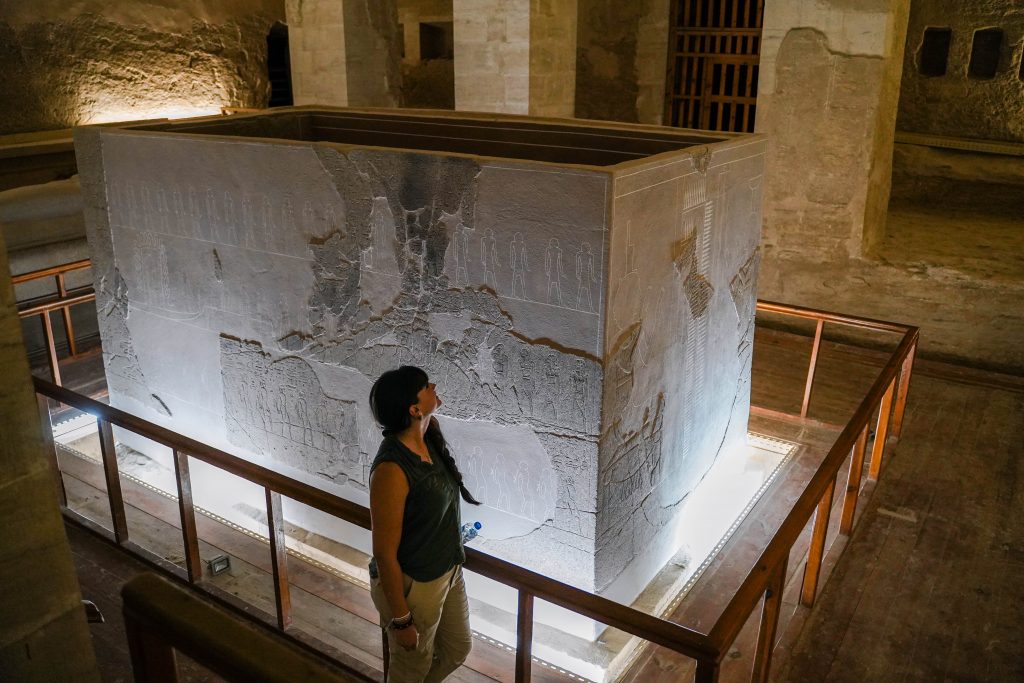
This was the first tomb we visited and while it wasn’t the most spectacular, it was somewhat unique. It was in the highest state of disrepair with much of the decorated plaster missing. Where the plaster remained however there were brilliantly colored drawings and the final burial chamber is an impressive size (maybe second to only Ramesses VI that we visited) It’s all a downhill walk and was the deepest tomb we visited.
Tomb of Ramesses I (KV16)
This was the 2nd tomb we visited and was a nice lead up to Ramesses III. It’s a short and sweet tomb that drops quickly with a smaller burial chamber that was likely meant more to be part of the corridor but had to be finished quickly due to the early death of the king. The depictions in this tomb are very vibrant and if you’re a fan of the god Anubis, this tomb features a lot of him well.
Tomb of Ramesses III (KV11)
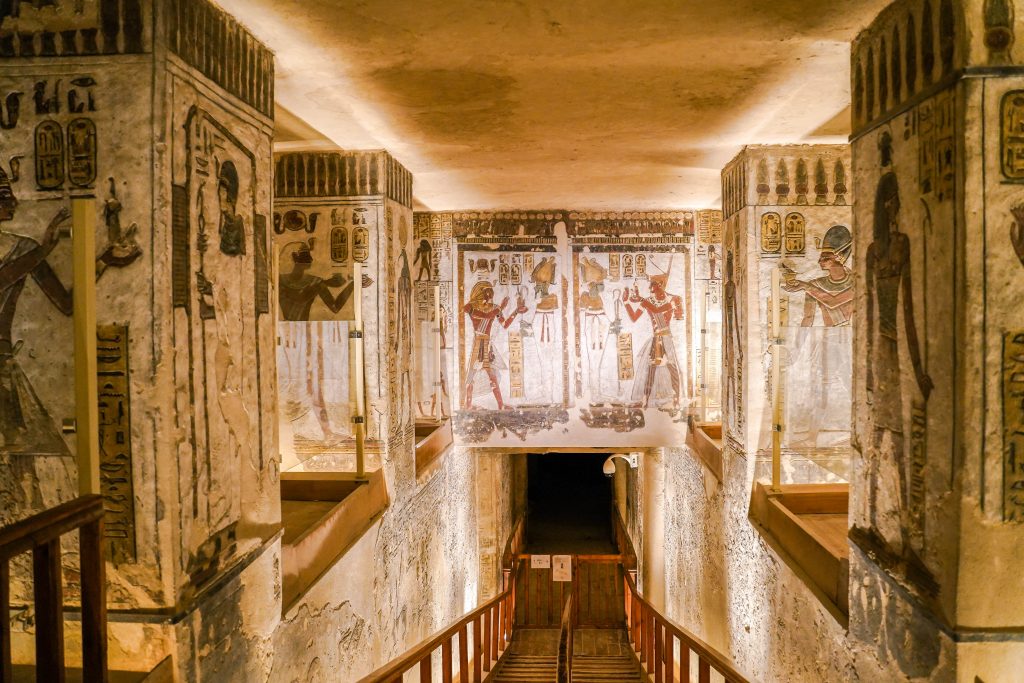
This tomb was our favorite of the “included” tombs we saw. The colors and depictions were the most vibrant and it was one of the larger tombs we visited taking the most time to take it all in. Ramesses III is also one of the more interesting kings to learn about as he had a long reign that ended with a murderous plot and likely his murder (though that is still being proven). This tomb is actually unfinished as well because at the time of his demise, the workers who were building his tomb went on strike for missing wages. If this tomb is open on your visit I definitely recommend it over the other 2 we saw.
Tomb of Ramesses V and VI (KV9)
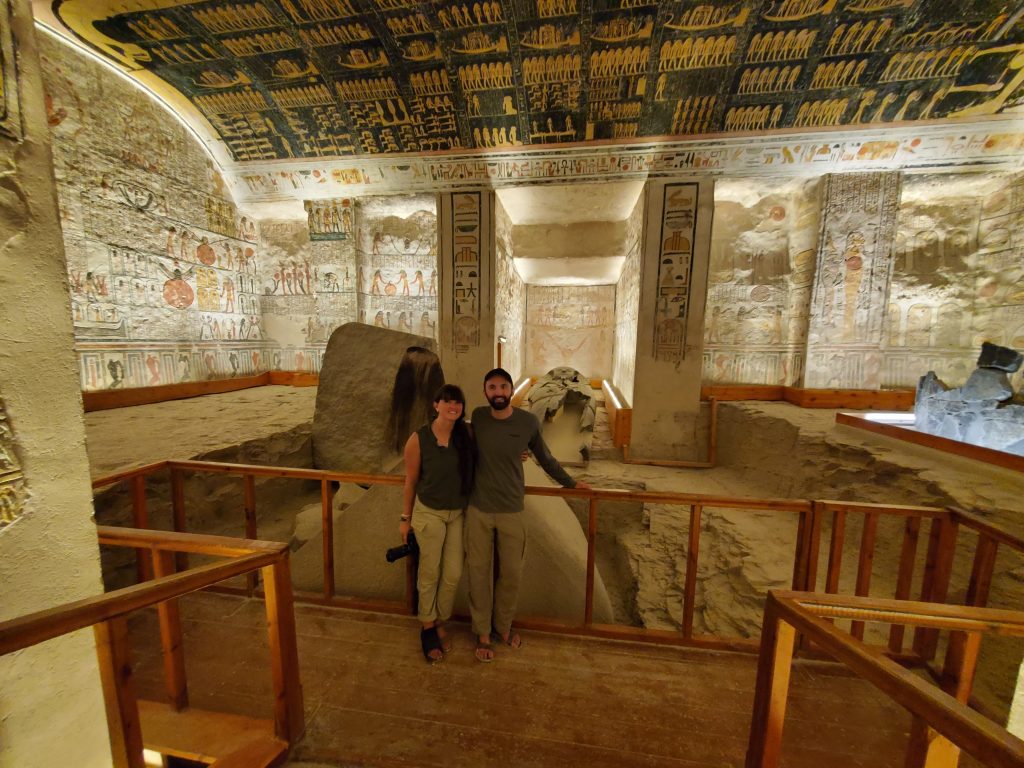
This was definitely our favorite of all the tombs. It features a very long hallway, series of staircases, and massive burial chamber featuring the sarcophagus in an interesting position that appears as if it was just discovered. The depictions in this tomb are also pretty clear in containing the book of the Heavens (the regeneration of the sun god with each new day) and the book of the dead. The ceiling in the burial chamber has a beautiful depiction of the sky and stars goddess Nut wrapping around the beautiful night sky.
Our overall experience:
Visiting the valley of the kings took much less time that I expected as most of the tombs are straightforward and quick to visit. We took the train which avoided most of the very hot uphill walking and enjoyed most of the tombs completely to ourselves. While I may enjoy the soaring temples in memory the most, the original colors in these tombs are not to be missed. We also largely had the tombs to ourselves thanks to visiting during the heat of the summer and Covid putting a damper on travel.
As a final note, beware the locals in the tombs acting as “tour guides.” This includes even the ticket guy. Since your guide won’t be allowed in the tombs with you, there’s a strong likelihood you’ll be approached by these guys. If anyone starts to point things out and follow you, say you don’t need a guide and avoid encouraging them unless of course, you find them interesting and want to tip them on your way out.

